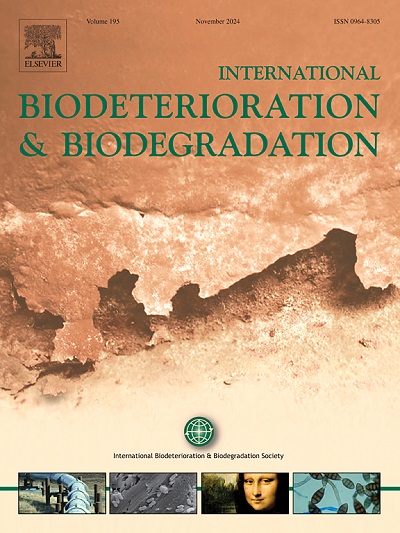红树林沉积物中质球微生物群落的动态及其对氮循环的潜在影响
IF 4.1
2区 环境科学与生态学
Q2 BIOTECHNOLOGY & APPLIED MICROBIOLOGY
International Biodeterioration & Biodegradation
Pub Date : 2024-09-26
DOI:10.1016/j.ibiod.2024.105929
引用次数: 0
摘要
塑料污染已成为海洋生态系统中的一个重大环境问题。塑料在红树林沉积物中的长期存在会对这些重要环境的碳和氮循环产生重大影响。我们进行了原位埋藏暴露实验,以评估红树林沉积物中生物可降解塑料和难降解塑料上的微生物定植和活动,重点研究它们对氮循环的影响。塑料表面微生物群落演替和代谢过程的变化主要取决于塑料聚合物的类型。暴露 60 天后,可生物降解塑料上反硝化细菌和反硝化相关基因(narG、nirS、nosZ 和 norB)的丰度较高。但在 360 天后,难降解塑料上的氨氧化古细菌和硝化相关基因(pmoA-amoA、pmoB-amoB、pmoC-amoC 和 hao)的丰度较高。因此,红树林沉积物中的塑料污染可能会破坏这些生态系统中的氮循环平衡,这就强调了在重要的沿海地区控制和减轻塑料污染的有害影响的极端必要性。本文章由计算机程序翻译,如有差异,请以英文原文为准。
Dynamics of plastisphere microbial communities in mangrove sediments and their potential impact on N-cycling
Plastic pollution has emerged as a significant environmental issue in marine ecosystems. The prolonged presence of plastics in mangrove sediments can have a substantial impact on the carbon and nitrogen cycles of these vital environments. We conducted in situ burial exposure experiments to assess microbial colonization and activity on biodegradable and refractory plastics in mangrove sediments, with a focus on their influence on nitrogen cycling. Variations in microbial community succession and metabolic processes on plastic surfaces were primarily determined by the type of plastic polymer. After 60 days of exposure, the abundance of denitrifying bacteria and denitrification-related genes (narG, nirS, nosZ, and norB) was higher on biodegradable plastics. After 360 days, however, a high abundance of ammonia-oxidizing archaea and nitrification-related genes (pmoA-amoA, pmoB-amoB, pmoC-amoC, and hao) were found on refractory plastics. Consequently, plastic pollution in mangrove sediments could disrupt the nitrogen cycling equilibrium in these ecosystems, underscoring the critical necessity to regulate and alleviate the detrimental impacts of plastic pollution in crucial coastal areas.
求助全文
通过发布文献求助,成功后即可免费获取论文全文。
去求助
来源期刊
CiteScore
9.60
自引率
10.40%
发文量
107
审稿时长
21 days
期刊介绍:
International Biodeterioration and Biodegradation publishes original research papers and reviews on the biological causes of deterioration or degradation.

 求助内容:
求助内容: 应助结果提醒方式:
应助结果提醒方式:


